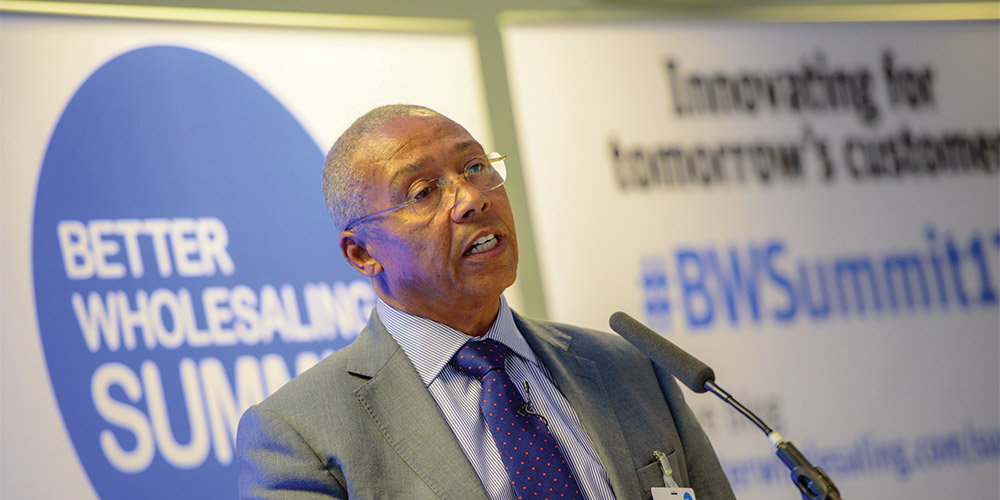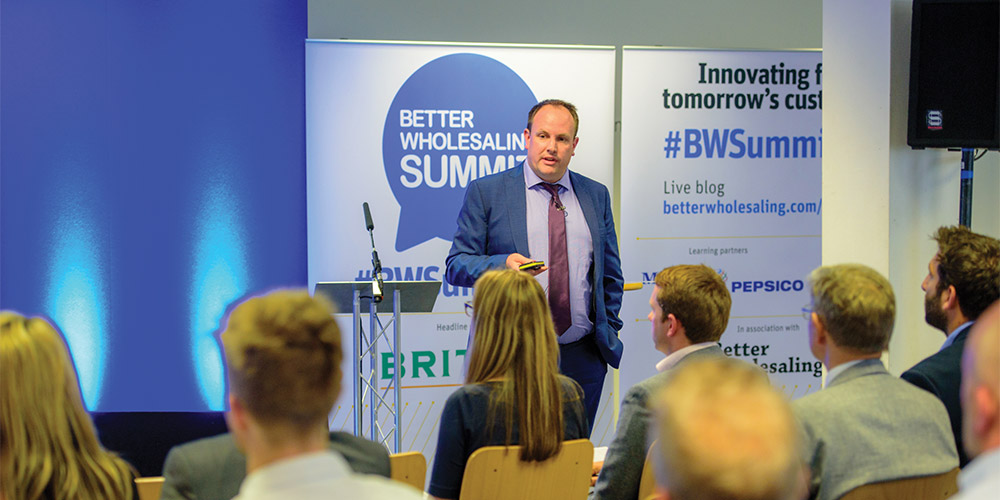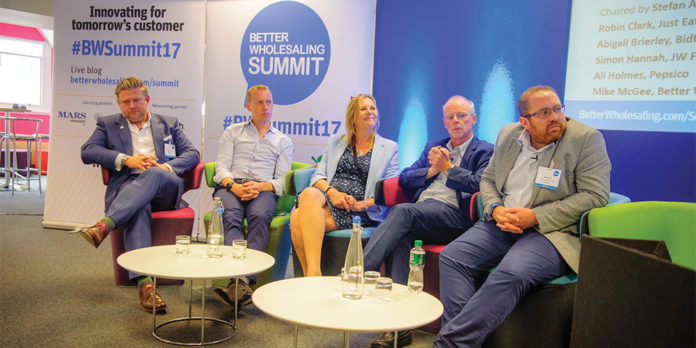Priyanka Jethwa reveals the key messages and action points delivered at this year’s Better Wholesaling Summit by leading wholesale decision-makers and suppliers.
Three hot topics were up for discussion at this year’s Better Wholesaling Summit, which was attended by a range of leading wholesale decision-makers and suppliers.
These were: Tech – The Next Step, featuring a keynote speech from takeaway giant Just Eat’s director of restaurant services Robin Clark; Balancing Foodservice and Retail, featuring Aris Poulis, managing director of Hyperama Wholesale, who shared insights into why wholesalers need to be in foodservice; and Keeping Up With The Customer, with Joanna Feeley, the MD of Trend Bible and former head of trends at Tesco, delivering a thought-provoking presentation on the trends set to dominate the market in the coming years.
Here are 50 of the most important take-home messages and quotes from #BWSummit17, which took place at The Studio in Birmingham on 13 July, and which was a trending topic on social network Twitter in the West Midlands area.
Session 1: Tech – The Next Step
- Just Eat has evolved from “disruptor to challenger to market leader” in the takeaway industry – £1.5bn of takeaway orders went through the platform last year.
2. The average Just Eat customer has 17 apps on their smartphone, but they are “looking for the dominant one” – the app that is the simplest to use
3. Takeaway is no longer just a Friday night treat. Consumers also want choice and convenience provided through ‘digital high streets’ that show them their favourite local dining brands.
4. Catering to differing buying habits is the key to staying competitive. For maximum profit, wholesalers should therefore ensure their online services are omnichannel.
5. Just Eat has a partnership with Booker and Makro that helps its affiliated restaurants save up to 7% per year.
6. JW Filshill already uses technology to increase efficiency, and works on the idea that data analytics is the “only game in town” in which to invest.
7. Filshill is launching its own YouTube channel, which will “reveal secrets” and raise awareness of the wholesale sector.
8. The relaunch of Filshill’s online ordering system has highlighted trends such as the fact 75% of customers are ordering energy drinks when looking at Heineken.
9. Filshill’s investment in Flavourly.com, a craft beer and craft spirits club, has given it access to key consumer stats to track trends and behaviours in the premium alcohol category.
10. Personalisation is key to marketing success: if you invest in a personal dialogue with your digital community, it can lead to “building deeper affiliations” with the products you offer.
11. Robin Clark: “We have an army of tech engineers, but being focused while also creating room to push boundaries is a challenge.”
12. Simon Hannah: “The nervousness to trust an app shows that people lack confidence in using tech. We need to get wholesalers understanding the value of it.”
13. Abigail Brierley: “We need to simplify the state of systems, break the journey down into bitesize chunks and learn how to create tech that is agile.”
14. Ali Holmes: “The next wave of change could see the rise of voice recognition technology, so make sure your infrastructure can adapt and change to aid this.”
15. Mike McGee: “You need to know what your business is and what it needs before investing – we have a long way to go in making ecommerce personalised.”
Session 2: Balancing Foodservice and Retail
16. From 2015 to 2017, Hyperama Wholesale’s retail sales have fallen by 3%, but its catering sales are up 11% and footfall is up 4%. It has adjusted depot layouts to reflect this trend.

17. These infrastructural efficiency improvements are being realised in Hyperama’s cash & carries by separating and signposting the catering from retail sections.
18. The company has invested £4m in acquiring new freezers and chilled rooms, which has led to growth increasing from 12% last year to 15% this year.
19. Hyperama has improved its catering offer by introducing bespoke pricing strategies that include market price audits, continuous commodity cost checks and promo evaluations.
20. In an effort to further boost its catering capabilities, Hyperama plans to work with and invest in suppliers and businesses that specialise in different cuisines.
21. With trends continually changing, Bidfood asks its customers what’s ‘in’. Singaporean and Far East cuisine are currently on trend, and Bidfood is making sure it caters to this demand.
22. For Bidfood, the idea of developing its offering involves sourcing the best products from its branded partners, creating its own dishes and investing in recipe development.
23. The company has hired a business analyst in an attempt to offset food inflation and help market its food offering by inspiring creativity among its customers.
24. Bidfood brought in a web designer, who said the company’s customer base was looking at its channel for new concepts. A YouTube video on sea bass hit 15,678 views in two days.
25. Bidfood sees inspiring new talent as key – its Future Chef programme goes to schools and gives the wholesaler the opportunity to engage with the foodservice industry.
26. Aris Poulis: “You must understand every corner of your business; new things are always happening. You can add value in the marketplace by investing in new trends.”
27. Andy Kemp: “Food-to-go may be the route to take for retailers suffering the loss of CTN sales.”
28. James Russell: “Foodservice is a growing area for us, but UK figures are only half of those in the US, so we need to see more food-to-go outlets.”
29. Ayman Nasreldin: “In the past six years, foodservice has moved to become the leading contributor to growth in the total retail market versus online grocery.”
30. David Gilroy: “You have to be clear on who your target audience is when venturing into catering – people from different regions want different foods.”
Session 3: Keeping up with the customer

31. ‘Hero’ images are needed online, along with an emphasis on what wholesalers’ online offers are, to help compete with the likes of Amazon.
32. Wholesalers need to work together to ensure that millennials understand the employment opportunities the sector provides.
33. Wholesalers need to think about the customer journey, in order to improve compliance and customer discipline in-store.
34. There is 80% discussion and only 20% execution from conversations between wholesalers and suppliers – be mindful that actions speak louder than words.
35. The sector desperately needs an aligned approach with data, especially around category descriptions and ‘sales-in’ data.
36. Soft drinks are the main reason people visit convenience stores. Thus, the sugar levy may encourage consumers who don’t want to change habits to spend more.
37. The biggest macro trend in the market is low/no-sugar products. By the time the sugar levy comes into force in April, it won’t apply to 95% of Britvic’s brands.
38. Selling more low/no-sugar soft drinks is a way to get around the tax; Britvic has been reformulating its range since 2012 to enable consumers’ palates to adapt.
39. Britvic has consistently innovated with and spent heavily on marketing for low/no-sugar products. Recent launches include Pepsi Max Ginger.
40. In a study Britvic conducted with 6,500 consumers, it was found that consumers want a low-sugar drink, but they still want choice.
41. If trends don’t help you stay relevant, then investing in them is futile.
42. Treat flavour and quality as one – consumers don’t expect to compromise on either.
43. The ‘social home’ trend has seen consumers increasingly enjoying ‘party-at-home’ evenings, which they post about online – so never underestimate visual social media’s power.
44. Excess packaging is a problem and brands aren’t addressing this intelligently – after all, nearly half of all adult-eating occasions happen alone.
45. There has been a 360% rise in veganism in the past decade, as well as growing interest in gluten-free and vegetarian diets.
46. Martin Race: “To inspire customers, you need to get your business online and ‘on app’ – we and the suppliers often forget that.”
47. Martin Race: “The biggest trends for the wholesale channel to be mindful of are premiumisation, healthy food and food to go.”
48. Joanna Feeley: “People undersell how valuable a fad can be. If you can get quickly behind a trend, it can be successful if you deliver it properly.”
49. James Bielby: “C-store shoppers can be far away from trends – wholesalers should be aware of trends, but they shouldn’t tear up their offers for them.”
50. Trystan Farnworth: “The sugar levy will accelerate the biggest soft drinks trend, so getting your category ready will benefit your business.”









[…] Cover story: 50 things we learned at the #BWSummit17 http://www.betterwholesaling.com/50-things-bw-summit/ […]